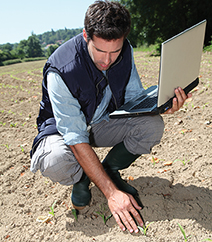Welcome to Blue Book!
Are you ready to join the thousands of companies who rely on Blue Book to drive smarter decisions? View our plans and get started today!
Still have questions? We’d love to show you what Blue Book can do for you. Drop us a line– we’ve been waiting for you.

While battling Mother Nature is something growers have dealt with since the beginning of time, today’s water shortages represent an entirely different kind of struggle. As the West’s drought heads into its fifth year, growers in California—and across the country—are still seeking both short- and long-term answers.
Previous Preparations for a Rainy Day
Designed with the future in mind and famously boasting the ability to “withstand a seven-year dry period,” California’s aqueduct system should have been able to endure the state’s ongoing drought conditions. The region’s recent El Niño weather pattern—which ushered in warmer and wetter conditions than usual to the Pacific Northwest, and a previous El Niño back in 2009 and 2010—should have augmented supply levels and led to more water for growers. Unfortunately, this has not been the case.
As far back as 1962, President John F. Kennedy broke ground on several significant reclamation projects, intended “to make life easier” for future generations by conserving resources to be better utilized by all. The most significant of these was the San Luis Dam, part of the California Water Project, a complex aqueduct system of more than 700 miles of reservoirs, canals, tunnels, pumps, and pipelines. Sadly, the San Luis Reservoir created by the dam and the largest off-stream reservoir in the United States, is experiencing water levels of only 51 percent of its historical average, down 7 percent just this year.
Since 1979, over 30 dams have been removed in California, eliminating over 100 billion gallons of water storage and leaving half of the state’s rainfall uncaptured according to the National Alliance for Environmental Reform. Of the water that has been captured, more than 1.4 trillion gallons has been flushed out to the sea since 2008—which the Wall Street Journal projected would have been enough water to support about 6.4 million Californians for six years.
Much of the progress President Kennedy and others worked for has disappeared. With other key produce growing states (i.e., Florida and Texas) passing legislation to improve water storage and management systems, many hope California will be able to follow suit and reform the state’s failing water management policies—before it decimates more of the agriculture industry.
Extreme Weather
While it is true this season’s El Niño weather produced much rainfall like in ‘Miracle March’ and shored up California’s snowpack (a welcome rebound from last year’s record lows), the water crisis is far from over—despite proclamations from some areas in northern California where usage restrictions are being reduced or lifted. For downstate growers, however, there has been little impact. The same can be said for portions of Texas, both last year and earlier this year, where some counties remained dry as others received historic rain and flooding. Florida, too, was affected as prime growing areas received an overwhelming amount of precipitation.




